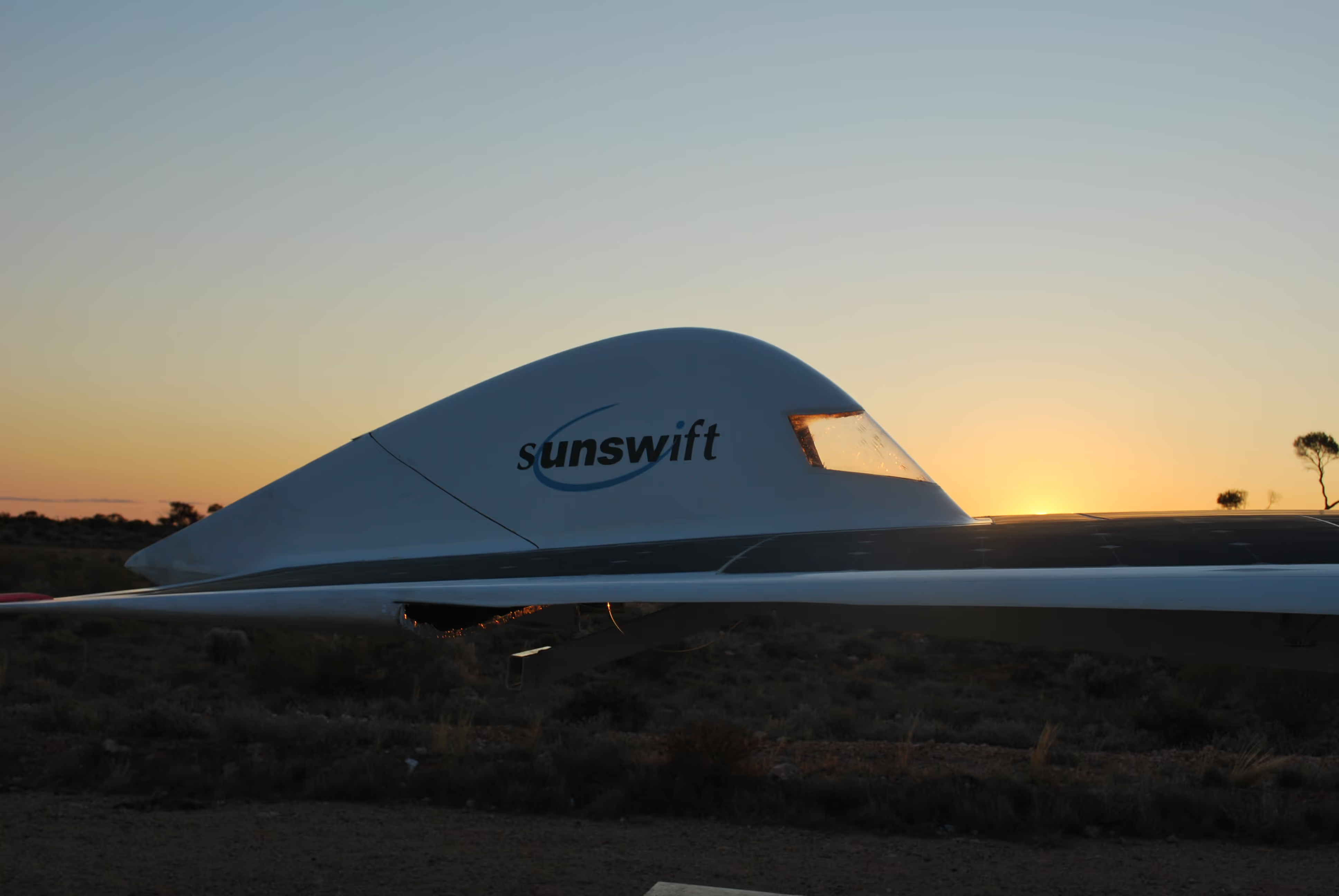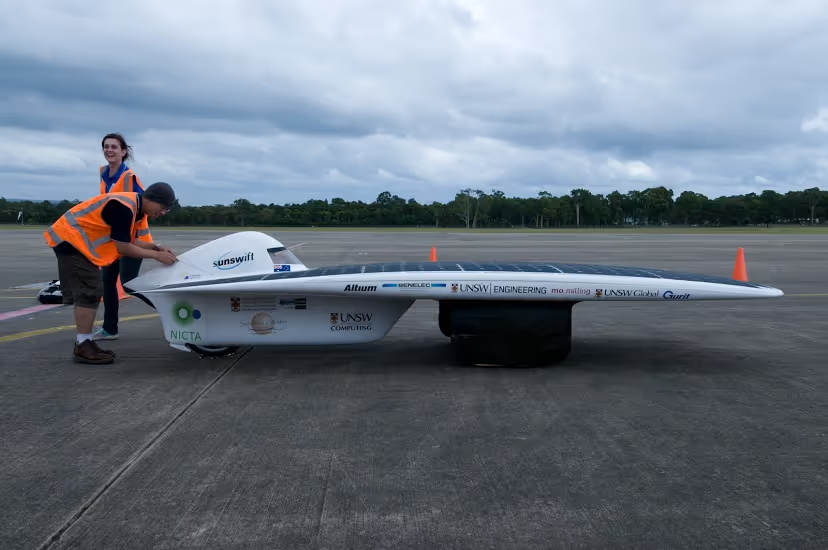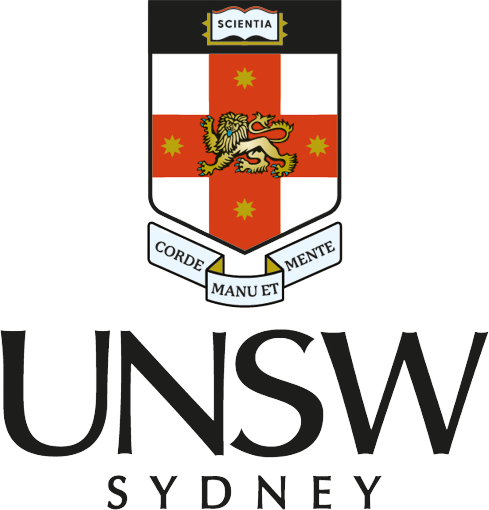Clara Mazzone was sitting nervously in the Dean of Engineering's office. She was the last remaining Sunswift team member after the 2007 World Solar Challenge (WSC), and by default, Sunswift’s newest Project Manager.
.jpg)
As the team’s only representative, Clara was invited to meet with faculty members to discuss one thing: Sunswift’s future.
And in this meeting, the faculty did not shy away from raising one distinct possibility.
Sunswift was going to shut down.
Although the victory of breaking the Transcontinental Record in 2007 was fresh as the dust still settling on the route’s desert-road track, the university had thought that the solar car team had perhaps served its purpose.
All of its successes – in racing; in testing the boundaries of sustainable technology; in showing just what extraordinary feats a group of dedicated university students can achieve – all of it was coming to an end.
Clara, however, was not so easily convinced. The second-year Renewable Energy engineering student had a plan.
The Plan
Step one – recruit more members.
“At the time there was…no team,” says Graham Doig, then Sunswift IV, or IVy’s, Head of Aerodynamics. “It’s hard to understate the mountain Clara had to climb. Most of the ‘old guard’ had left and a new car had to be built from scratch.”
Clara began repopulating the team by approaching several Sunswift alumni to mentor the team – David Snowdon, Chief Engineer of Sunswift III, was one of them. Graham, who had worked on previous iterations of the car, was another.
A strong recruitment drive saw about 30 new members swell the ranks, and just like that, Sunswift IVy was up and raring to go.
Step two – develop a solid business plan.
.avif)
Clara recognised that for the future of the team to survive, simply building a car was not enough. They needed to look at the bigger picture, to make sure that Sunswift’s impact can be felt beyond the race track.
“How do you actually effectively run a team and what does that look like and how do you motivate people?” asks Clara. “What does a culture mean? How do we make sure the culture that we support internally is also what we say we are?”
To answer these questions, Clara used the WSC 2009 launch night as a way to present the team’s renewed professionalism to UNSW and potential sponsors.
With each member clad in corporate attire complete with engraved, magnetic name tags on their breast pockets, first impressions were everything. And although the car was late to its own launch, the team’s efforts appeared to have paid off when they received a final $20,000 for their race funds after the launch.
Clara and the Sunswift Business Team also increased the scope of the team’s education outreach programs. Sunswift travelled to various fairs and schools in regional New South Wales for the dual purpose of testing the car on the road and educating students about the future of sustainable technology.
“It was really important for us to educate the public, especially children, about the promise of renewable energy and the importance of energy efficiency,” says Kristen Casalenuovo, IVy’s Business Lead. “It was definitely a highlight of my time.”
Step three – build a well-performing car.

The 2009 WSC saw a significant change in the car design rules. For the first time, drivers were required to sit at almost an upright position with the seat angle not more than 27˚, posing a few challenges for the team in optimising the car’s aerodynamics.
Graham, with a group of engineering students, undertook the project to design the car. The design was completely digital and finished without access to a wind tunnel.
“We had to simply rely on our best training to ensure that the values for aerodynamic resistance and stability were within performance and safety margins,” he says.
From prototype to the final model, the team had successfully reduced the aerodynamic resistance of the car by 50 per cent.
“I have little doubt that it was the ideal car for that race at that time in that class,” says Graham.
The Head of Aerodynamics also took a few liberties with the aesthetic design of the car, integrating the indicator lights with IVy’s famous “bat wing” swoop on the rear for the vehicle just “to look dramatic”.
“There was perhaps some suspicion from some of the team that we were making a car that was a little out of step with other designs that had been successful,” he explains. “Well…we didn’t just want the best-performing car, we wanted the best-looking car too!”
Step four – make safety a priority.
.avif)
A few days before the car was due to race in the 2009 WSC, the team had a serious discussion about the potential safety limitations of the vehicle. The car was not yet complete.
“We ended up having a team meeting going ‘are we being sensible, are we putting a car on the road that could endanger people’s lives?” says Clara.
And even after the team ultimately made the decision to drive the car, Clara continued to prioritise the safety and wellbeing of team members while on the race.
“I was really strict with everyone,” she says. “Sometimes I look back and go, ‘Oh gosh. I made them sit down and watch, before the race, videos on what sleep deprivation does to you and driving while drunk’.”
These talks proved useful, however, when IVy became the first silicon car to cross the finish line, with the race as smooth as can be.
With this victory behind them, IVy successfully escaped from cancellation.
The Guinness World Record
.avif)
In 2010, the team turned their attention to their next project: the Guinness World Record attempt for fastest land speed – then held by General Motors’ Sunraycer for reaching a top speed of 79km/hr in 1988.
The team had first considered completing this record in 2006 during the Sunswift III era, according to Graham, but the “idea went on the backburner” as Sunswift III retired and the team focused their efforts on building IVy.
But the team decided that now was the right time to give this record a go. “We wanted to see what the car was capable of doing,” said Daniel Friedman, IVy’s second Project Manager. “That’s when we decided to have another crack at the World Record.”
The team spent months looking for the perfect location for the Guinness World Record attempt. Their search eventually led them to the HMAS Albatross in Nowra, NSW, an active navy base.
The rules of the attempt required the car to complete two runs in opposite directions on a near-flat track with the battery pack removed, which meant the car must commence from a standing start.
Barton Mawer, a professional solar racer, was selected to be the driver for this attempt as his slight stature allowed him to fit in IVy’s tight seating pod.
Barton is a renowned racer and had previously competed in Australia, Europe and America, bringing in his expertise to complete the attempt without any issues.
“Cutting-edge development excites me,” he says. “I got sucked in by the team’s vision and excitement.”
Despite the overcast weather during their mid-morning start, IVy reached a top-speed of 88.7km/hr, breaking Sunraycer’s record by almost 10km/hr.
The WSC 2011
.avif)
By the time the WSC 2011 arrived, IVy had been fitted with a rebuilt chassis, a new array and had undergone some mechanical modifications.
The race that year, however, was marred with bushfires, rain and thunderstorms. As a result of the bushfires, teams were stopped mid-race, forcing them to put up camp before the day’s end and losing a couple of hours on the road.
“If it weren’t for the officials of the race, we probably would have tried to drive through the bushfire,” laughs Kristen, a driver in the WSC 2011.
For Jono Pye, IVY’s Assistant Project Manager, however, the highlight of the entire race was the moment they overtook the MIT solar team.
“We’d been chasing them – we had issues on the first day, so we were taking over the rest of the pack until only MIT was in front of us,” he says, laughing. “They had a flat tyre and we stopped at the control point.
“So we were on the start line, itching to go…and they managed to swap the wheel out and get out like 30 seconds in front of us just to make us drain the battery.
“But then I got to make the call on the radio: ‘MIT this is Sunswift, do you copy? We’re about to overtake you’.
“In the next half an hour we overtook them and took the lead in the race.”
Seven days later, IVy came 1st in the Production Challenge Class and 6th overall.
For Graham, who was not on the team in 2011 but became an academic supervisor in 2013, this win was a turning point in Sunswift’s solar racing history - one that guaranteed Sunswift’s future.
“This result really solidified that Sunswift was a top-tier contender that could pull out consistent results,” he says.
“I think, even more than the [Guiness World Record attempt], this secured the university’s long-term support for the project.”

WSC 2009 (Global Green Challenge) Team Members
Clara Mazzone, Jono Pye, Alex Boulgakov, Etienne Le Sueur, David Snowdon, Irving Tjiptowarsono, Daniel Friedman, Campbell McLaren, Luke Bycroft, Yi Syuen Lim, Sam Paterson, Helga Prochaska, Glen Summers, Authur Collins, Joe Wolfe, Caitlin Trethewy, John Durrant, Claudia Williams, Scott McDaid, Nick Kerrigan, Tim Wardrop, Graham Doig.
WSC 2011 Team Members
Daniel Friedman, Sam Paterson, Jono Pye, Etienne Le Sueur, Tommy Heyser, Campbell McLaren, Robby Hutchinson, Kelvin To, Karina Hudson, Kristen Casalenuovo, Alexandra Boulgakov, Glen Summers, Irving Tjiptowarsono, David Favaloro, Charith Perera and Andrew Delmar, Nick Clark, Professor Joe Wolfe, David Snowdon, Scott McDaid, Luke Bycroft, Nick Kerrigan and Matt Cumming.
Related Achievements
Guinness World Record '11
Fastest Solar Powered Vehicle: 88.8 kilometres per hour (55.2mph).
World Solar Challenge '09
Sunswift IV finished 1st in the Silicon Challenge Class and 4th overall at 3:08pm on 29 October.
World Solar Challenge '11
Sunswift IVy finished 1st in the Production Challenge Class and 6th overall.


